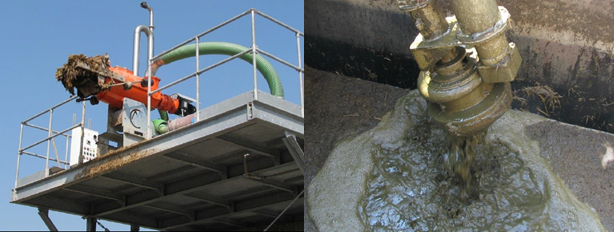(E)-mission is a EIP-Agri project
In this trial, cattle manure was separated into solid-liquid. The concentration of nutrients in the solid phase is relatively low. The liquid phase was used to fertilize the field.

 Left: composition of solid phase (IT) Right: composition liquid phase (IT)
Left: composition of solid phase (IT) Right: composition liquid phase (IT)The cattle slurry was applied during autumn, winter or spring:
- M1 - Autumn (mid October 2017)
- M2 - Winter (mid-January 2018)
- M3 - Spring (end March 2018)
In all three seasons, the manure was applied with spraying, on the surface or via injections. This was mainly to analyse the amount of gases lost via the air. This will not be discussed in this part.
The graph below shows the effect of seasonal application on forage production. Here you can see that spring application (M3) leads to the highest production (numerical).

For the quality of the forage, protein and nitrate concentration of the plant was measured. For both elements, spring application showed the best results. In addition, the way of applying the fertilizer also has an influence on the quality of the forage.

Nitrates in soil water retention where high when manure was applied during winter (first graph, M1). The lowest levels of nitrates in the soil water were seen during spring fertilization.

Values/benefits
-Timing can be linked to quality and production
-Combining the timing with an optimal fertilization technique
Challenges/bottlenecks
-Way of application also influence
Lessons learned
-End of growing season à growth and N uptake reduced à oversupply of inorganic N
-Ideally: apply right before need is the highest (from seedling to late tillering stage in cereal grains and seedling to early branching in oil seeds)
Impact on
- Socio-economic resilience: Possible that the workload will increase
- Animal health and welfare: Unknown effects on animal- health and welfare
- Production efficiency and meat quality: Forage production will increase, also quality (will influence the animals)
- Environmental sustainability: Nutrient leaching is decreased when applied in early spring. How big the impact is is difficult to say and farm dependent
Link to project (in Italian)
Background of the project
The sustainable agricultural production system to be developed is based on a set of fundamental agronomic techniques, such as proper slurry management (both in terms of method and timing), permanent soil cover or minimal soil disturbance through permanent grassland or the use of temporary cover crops. This system aims to increase biological activity and soil fertility, enhancing biodiversity, the accumulation of organic matter in soils and in particular to reduce nitrogen losses to the atmosphere and water.
In fact, about 10% of greenhouse gases (GHGs) in the EU-28 are attributable to agricultural activities and the European Union has set itself the task of adopting mitigation measures also for the agricultural and livestock sector in order to meet its commitments to combat climate change.
The general objective of the project is to promote sustainable agriculture from an agronomic, environmental and socio-economic point of view. The actions of this project aim at reducing greenhouse gas and ammonia emissions in the main regional agro-livestock sectors (Parmigiano-Reggiano and Grana Padano). To achieve this goal, innovative agricultural systems will be studied that reduce emissions through virtuous agronomic practices in the use of livestock manure. The experimental actions will evaluate the effect of cover crops, timing and alternative wastewater distribution systems on greenhouse gas emissions from agricultural land.
The specific objectives are based on the study of an innovative agro-technique that promotes on the one hand the efficient uptake of nutrients supplied in the autumn-spring period and on the other their reorganisation into stable forms in the soil, while reducing their loss through volatilisation (NH3) and denitrification (N2O). This leads to a more rational use of agricultural inputs, emphasizing the agro-ecological re circulation of natural resources, containing cultivation costs, and reducing environmental risks including nitrate leaching to water.
An accompanying objective is to reduce the use of synthetic mineral fertilizers (especially nitrogen fertilizers, by limiting nitrogen losses from effluents distributed in autumn-spring) in order to reduce pollution generated by agricultural activity and to improve water, air and soil quality.